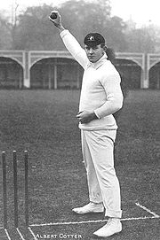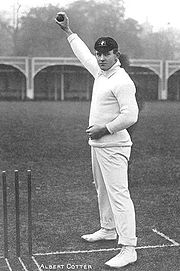
Tibby Cotter
Encyclopedia
Albert "Tibby" Cotter was an Australian cricketer
who played in 21 Tests
between 1904 and 1912.
Arguably the best fast bowler through the first decade of the 20th century he had a reputation for breaking stumps. Early moving film of his action clearly shows a slinging action that was to cause controversy in England.
While regarded as the fastest of his era in Australia (his pace saw him nicknamed "'Terror' Cotter" by English fans) he did not always have the control to back it up, hitting W.G.Grace on the body with a full toss on his first tour of England.
He took eight or more wickets in a match four times from his 21 Tests and his strike rate of 52 ranks up with the best.
Cotter missed the tri-nations tour to England in 1912 when he was among the six players who refused to tour
due to a dispute with the Board of Control. He was never to play for Australia again.
 Cotter joined the Australian Imperial Force
Cotter joined the Australian Imperial Force
(AIF) in April 1915, aged 31. The enlistment of a former sporting champion was seen as powerful publicity for the AIF recruiting campaign.
Despite having no great riding ability, he was accepted into the 1st Australian Light Horse Regiment; he took a late part in the Gallipoli campaign. Later he transferred to the 12th Light Horse
and was commended for his “fine work under heavy fire” during the second battle of Gaza
. The official history remarked: “he behaved in action as a man without fear”. He declined promotion.
On 31 October 1917 the 4th Light Horse Brigade
, of which the 12th Regiment was part, captured Beersheba by a brilliant cavalry-style charge. Cotter was there as a stretcher-bearer. At the end of the charge, as troops dismounted to engage the enemy, a Turk shot Cotter dead at close range.
Cricketer
A cricketer is a person who plays the sport of cricket. Official and long-established cricket publications prefer the traditional word "cricketer" over the rarely used term "cricket player"....
who played in 21 Tests
Test cricket
Test cricket is the longest form of the sport of cricket. Test matches are played between national representative teams with "Test status", as determined by the International Cricket Council , with four innings played between two teams of 11 players over a period of up to a maximum five days...
between 1904 and 1912.
Arguably the best fast bowler through the first decade of the 20th century he had a reputation for breaking stumps. Early moving film of his action clearly shows a slinging action that was to cause controversy in England.
While regarded as the fastest of his era in Australia (his pace saw him nicknamed "'Terror' Cotter" by English fans) he did not always have the control to back it up, hitting W.G.Grace on the body with a full toss on his first tour of England.
He took eight or more wickets in a match four times from his 21 Tests and his strike rate of 52 ranks up with the best.
Cotter missed the tri-nations tour to England in 1912 when he was among the six players who refused to tour
Big Six cricket dispute of 1912
The Big Six cricket dispute that occurred in 1912 was a confrontation between the administrators and players of the sport of cricket in Australia. Six of Australia's leading cricketers refused an invitation to tour England for the 1912 Triangular Tournament. The six players were Warwick Armstrong,...
due to a dispute with the Board of Control. He was never to play for Australia again.

Australian Imperial Force
The Australian Imperial Force was the name given to all-volunteer Australian Army forces dispatched to fight overseas during World War I and World War II.* First Australian Imperial Force * Second Australian Imperial Force...
(AIF) in April 1915, aged 31. The enlistment of a former sporting champion was seen as powerful publicity for the AIF recruiting campaign.
Despite having no great riding ability, he was accepted into the 1st Australian Light Horse Regiment; he took a late part in the Gallipoli campaign. Later he transferred to the 12th Light Horse
12th Light Horse Regiment (Australia)
The 12th Light Horse Regiment was a light horse regiment of the Australian Army. It was originally raised in 1915 for service during the First World War, the regiment served in the Middle East against the Turks before being disbanded in 1919...
and was commended for his “fine work under heavy fire” during the second battle of Gaza
Second Battle of Gaza
The Second Battle of Gaza, fought in southern Palestine during the First World War, was another attempt mounted by British Empire forces to break Ottoman defences along the Gaza-Beersheba line...
. The official history remarked: “he behaved in action as a man without fear”. He declined promotion.
On 31 October 1917 the 4th Light Horse Brigade
4th Light Horse Brigade
The 4th Light Horse Brigade was a mounted infantry brigade of the First Australian Imperial Force serving in the Middle Eastern theatre of World War I. The brigade was formed in March 1915 and shipped to Egypt without their horses and was broken up in Egypt in August 1915...
, of which the 12th Regiment was part, captured Beersheba by a brilliant cavalry-style charge. Cotter was there as a stretcher-bearer. At the end of the charge, as troops dismounted to engage the enemy, a Turk shot Cotter dead at close range.

